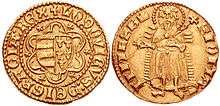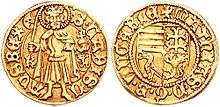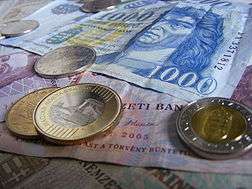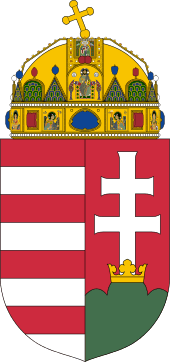Hungarian forint
| Hungarian forint | |
|---|---|
| Magyar forint (Hungarian) | |
|
Coins and banknotes of the Hungarian forint. | |
| ISO 4217 | |
| Code | HUF |
| Denominations | |
| Subunit | |
| 1/100 |
fillér (defunct) |
| Plural | not used |
| Symbol | Ft |
| Banknotes | 500 Ft, 1000 Ft, 2000 Ft, 5000 Ft, 10,000 Ft, 20,000 Ft |
| Coins | 5 Ft, 10 Ft, 20 Ft, 50 Ft, 100 Ft, 200 Ft |
| Demographics | |
| Date of introduction | 1 August 1946 |
| Source | 8.700/1946 (VII.29) Decree of the Prime Minister |
| User(s) |
|
| Issuance | |
| Central bank | Hungarian National Bank |
| Website |
www |
| Printer | Pénzjegynyomda Zrt. Budapest |
| Website |
www |
| Mint | Hungarian Mint Ltd. |
| Website |
www |
| Valuation | |
| Inflation | 1.3% |
| Source | June 2014[1] |
The forint (sign: Ft; code: HUF) is the currency of Hungary. It is divided into 100 fillér, although fillér coins are no longer in circulation. The introduction of the forint on 1 August 1946 was a crucial step of the post-World War II stabilization of the Hungarian economy, and the currency remained relatively stable until the 1980s. Transition to market economy in the early 1990s deteriorated the value of the forint; inflation peaked at 35% in 1991. Since 2001, inflation is single digit and the forint was declared fully convertible.[2] As a member of the European Union, the long term aim of the Hungarian government may be to replace the forint with the euro but that does not appear to be likely until some time during the 2020s.[3][4][5]
| 2 Hungarian forint (1989). | |
|---|---|
 | |
| Obverse: Coat of arms of Hungary and "Magyar Népköztársaság" (Hungarian People's Republic). | Reverse: Face value, year and currency. |
History


The forint's name comes from the city of Florence, where golden coins were minted from 1252 called fiorino d'oro. In Hungary, florentinus (later forint), also a gold-based currency, was used from 1325 under Charles Robert and several other countries followed its example.
Between 1868 and 1892 the forint was the name used in Hungarian for the currency of the Austro-Hungarian Empire, known in German as the gulden or florin. It was subdivided into 100 krajczár (krajcár in modern Hungarian).
The forint was reintroduced on 1 August 1946, after the pengő was rendered almost worthless by massive hyperinflation in 1945–46—the highest ever recorded. The process was managed by the Hungarian Communist Party, which held the relevant cabinet seats. The forint's success was exploited for political gains, contributing to the Communists' takeover of complete power in 1948–49. The forint replaced the pengő at the rate of 1 forint = 4×1029 pengő—dropping 29 zeroes from the old currency. In fact, this was an imaginary exchange rate. With the highest value note being 100 million B. pengő (1020 pengő), the total amount of pengő in circulation had a value of less than 0.1 fillér. Of more significance was the exchange rate to the adópengő of 1 forint = 200 million adópengő.
Historically the forint was subdivided into 100 fillér (comparable to a penny), although fillér coins have been rendered useless by inflation and have not been in circulation since 1999. (Since 2000, one forint has typically been worth about half a US cent or slightly less.) The Hungarian abbreviation for forint is Ft, which is written after the number with a space between. The name fillér, the subdivision of all Hungarian currencies since 1925, comes from the German word Heller. The abbreviation for the fillér is f, written also after the number with a space in between.
After its 1946 introduction, the forint remained stable for several years, but started to lose its purchasing power as the state-socialist economic system lost its competitiveness during the 1970s and 1980s. After the democratic change of 1989–90, the forint saw yearly inflation figures of app. 35% for three years, but significant market economy reforms helped stabilize it. Since year 2000 the relatively high value of forint (especially compared to the falling US dollar and to some extent to the euro) handicaps the strongly export-oriented Hungarian industry against foreign competitors with lower valued currencies.
Coins
In 1946, coins were introduced in denominations of 2, 10, 20 fillérs and 1, 2, 5 forints. The silver 5 forint was reissued only in the next year, later it was withdrawn from circulation. 5 and 50 fillérs coins were issued in 1948. In 1967, a 5 forint coin was reintroduced, followed by a 10 forint in 1971 and 20 forint in 1982.
In 1992, a new series of coins was introduced in denominations of 1, 2, 5, 10, 20, 50, 100 and (a somewhat different, 500‰ silver) 200 forint. Production of the 2 and 5 fillér coins ceased in 1992, with all fillér coins withdrawn from circulation by 1999. From 1996, a bicolor 100 forint coin was minted to replace the 1992 version, since the latter was considered too big and ugly, and could be easily mistaken for the 20 forint coin.
Silver 200 forint coins were withdrawn in 1998 (due to their nominal value getting too low compared to their precious metal content), the 1 and 2 forint coins remained in circulation until 29 February 2008.[6] The sum of total purchases is rounded to the nearest 5 forint (to 0 or to 5) when paid with cash.[7] A new 200 forint coin[8] made of base metal alloy was introduced in place of the 200 forint bank note on 15 June 2009.
Banknotes
In 1946, 10 and 100 forint notes were introduced by the Magyar Nemzeti Bank (Hungarian National Bank). A new series of higher quality banknotes (10, 20 and 100 forint) were introduced in 1947–48. 50 forint notes were added in 1953, 500 forint notes were introduced in 1970, followed by 1000 forint in 1983, 5000 forint in 1991.
A completely redesigned new series of 200, 500, 1000, 2000, 5000, 10 000 and 20 000 forint was introduced gradually between 1997 and 2001. Each banknote depicts a famous Hungarian leader or politician on the obverse and a place or event related to him on the reverse. All of the banknotes are watermarked, contain an embedded vertical security strip and suitable for the visually impaired people. The 1000 forint and higher denominations are protected by an interwoven holographic security strip. The notes share the common size of 154 × 70 mm. The banknotes are printed by the Hungarian Banknote Printing Corp. in Budapest on the paper manufactured by the Diósgyőr Papermill in Miskolc.
Commemorative banknotes were also issued recently: 1000 and 2000 forint notes to commemorate the millennium (in 2000) and 500 forint note to commemorate the 50th anniversary of the 1956 revolution (in 2006).
Forgery of forint banknotes is not significant. However, forged 20 000 forint notes printed on the paper of 2000 forint notes after dissolving the original ink might come up and are not easy to recognize. Another denomination preferred by counterfeiters was the 1000 forint note until improved security features were added in 2006.
List of current banknotes
All banknotes are 154 × 70 mm in size.
| Value | Image | Main Colour | Description | First Series | Latest Series | ||
|---|---|---|---|---|---|---|---|
| Obverse | Reverse | Obverse | Reverse | ||||
| 500 Ft |  |
 |
Orange and brown | prince sovereign Francis II Rákóczi | Castle of Sárospatak | Series 1998 | Series 2013 |
| 1000 Ft |  |
 |
Blue | King Matthias Corvinus | the Hercules Fountain from the Castle of Visegrád | Series 1998 | Series 2015 |
| 2000 Ft |  |
 |
Brown | prince sovereign Gabriel Bethlen | Viktor Madarász painting "Gábor Bethlen among his scientists" | Series 1998 | Series 2013 |
| 5000 Ft |  |
 |
Violet and green | count István Széchenyi | the Széchenyi Mansion in Nagycenk | Series 1999 | Series 2009 |
| 10 000 Ft |  |
 |
Red and blue | King Stephen I | view of Esztergom | Series 1997 | Series 2014 |
| 20 000 Ft |  |
 |
Grey and reddish | Ferenc Deák | the old House of Representatives in Pest | Series 2001 | Series 2015 |
Current exchange rates
| Current HUF exchange rates | |
|---|---|
| From Google Finance: | AUD CAD CHF EUR GBP HKD JPY USD CNY |
| From Yahoo! Finance: | AUD CAD CHF EUR GBP HKD JPY USD CNY |
| From XE: | AUD CAD CHF EUR GBP HKD JPY USD CNY |
| From OANDA: | AUD CAD CHF EUR GBP HKD JPY USD CNY |
| From fxtop.com: | AUD CAD CHF EUR GBP HKD JPY USD CNY |
Historic rates
|
Most traded currencies (from 31 December 1990):
Sources: arfolyam.iridium.hu |
Nearby county currencies (from 31 December 2010):
Sources: arfolyam.iridium.hu |
See also
References
- ↑ Központi Statisztikai Hivatal
- ↑ BBC News Hungary lifts last currency restrictions. 18 June 2001
- ↑ "Hungary's New Notes Speak of Late Conversion to Euro". The Wall Street Journal. 1 September 2014. Retrieved 24 May 2015.
- ↑ "HUNGARY'S ECONOMY MINISTER SEES POSSIBILITY FOR ADOPTING EURO BY 2020 – UPDATE". Daily News Hungary. 3 June 2015.
- ↑ "Hungary mulls euro adoption by 2020". BR-epaper. 19 July 2016.
- ↑ 1 and 2 forint coins are withdrawn from use from 1 March 2008.
- ↑ The sum of total purchases is rounded
- ↑ The new 200 forint coin
- Krause, Chester L.; Clifford Mishler (1991). Standard Catalog of World Coins: 1801–1991 (18th ed.). Krause Publications. ISBN 0873411501.
- Pick, Albert (1994). Standard Catalog of World Paper Money: General Issues. Colin R. Bruce II and Neil Shafer (editors) (7th ed.). Krause Publications. ISBN 0-87341-207-9.
Further reading
- Gyula Rádóczy; Géza Tasnádi (1992). Magyar papírpénzek 1848–1992 (Hungarian paper money 1848–1992). Danubius Kódex Kiadói Kft. ISBN 963-7434-11-9.
- Károly Leányfalusi; Ádám Nagy (1998). Magyarország fém- és papírpénzei 1926–1998 (Coins and paper money of Hungary 1926–1998). Magyar Éremgyűjtők Egyesülete, Budapest. ISBN 963-03-6023-3.
- Károly Léányfalusi; Ádám Nagy (2006). Magyarország fém- és papírpénzei 1946–2006 (Coins and paper money of Hungary 1964–2006). Magyar Éremgyűjtők Egyesülete, Budapest. ISBN 978-963-7122-16-3.
- Mihály Kupa id. dr. (1993). Corpus notarum pecuniariarum Hungariae I-II. (Magyar Egyetemes Pénzjegytár) (General Hungarian Banknote Catalog). Informatika Történeti Múzeum Alapítvány, Budapest. ISBN 963-04-3658-2.
External links
| Wikimedia Commons has media related to Money of Hungary. |
- Official Daily Exchange Rates Archive, Hungarian National Bank
- (Hungarian) (English) bankjegy.szabadsagharcos.org (Hungarian banknote catalog)
- (Hungarian) (English) www.numismatics.hu (Roman and Hungarian related numismatic site)
- (Hungarian) papirpenz.hu (pictures of Hungarian banknotes)
- (Hungarian) (English) (German) (French) www.eremgyujtok.hu (homepage of the Hungarian Coin Collectors' Society)
- Hungarian banknotes (high resolution pictures, also including old forint banknotes)
- Comprehensive catalog of Hungarian coins
- Hungarian National Bank – "Information on forint banknotes and their security features, and forint coins"
| Preceded by: Hungarian pengő Reason: inflation Ratio: 1 forint = 4×1029 pengő |
Currency of Hungary 1 August 1946 – Concurrent with: adópengő until 30 September 1946 |
Succeeded by: Current |
| Preceded by: Hungarian adópengő Reason: inflation Ratio: 1 forint = 2×108 adópengő |

